LNS Research’s annual, The IX Event, is a global platform for Industrial Transformation (IX) leaders to convene, share thought leadership and best practices, and discover new research and perspectives from the LNS Research Analyst Team and other top industry executives. This year’s event will take place in Chicago, October 17th-19th. The event theme is Operation 2030 - The Journey to Zero+, an industrial world with Zero Harm, Zero Waste, Zero Net-Carbon, Plus Step Change Productivity Gains. Quality Leaders reading this might not think this theme impacts them, but it does.
Good Quality is Green. We heard this message from past Hexagon CEO Ola Rollen in his opening keynote of the Hexagon event last year in Las Vegas. Of course, Mr. Rollen is correct. Good Quality is Green and can contribute significantly to reducing emissions, in addition to good quality being core to the concept of zero waste and step change productivity gains.
It’s only seven years until 2030. While this is certainly not the age of George Jetson, significant advances have occurred in Industrial Transformation in the last ten years. Some of these advancements are multiplicative for future advancements to occur rapidly. The question here is, what will Quality 4.0 look like for Industrials in 2030?
Quality 4.0 is for the expressed purpose of adding value for the customer. (Figure 1) Currently, among IX initiatives implemented across the enterprise or across the majority of the plant network, nearly 60% have a Quality 4.0 program within their scope. The trend in recent years continues with the growth of Quality 4.0 as a major element of an Industrial Transformation Strategy.
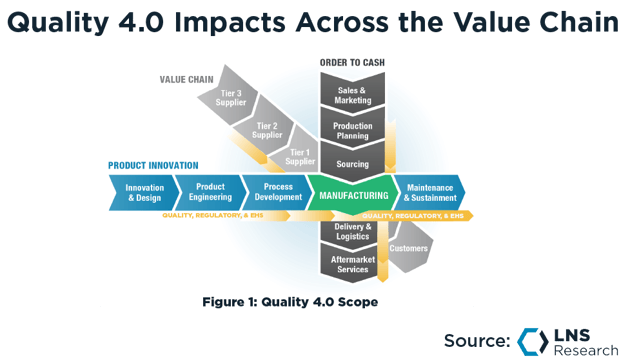
Specific Quality 4.0 trends worth additional exposure:
-
-
-
Technology nodes applied in combination (Vision Cameras on Robots) are experimental at this point.
We are seeing some industrials experimenting with combinations of technology for visual inspection tasks that reduce the human touch needed to perform the task and elevate the role of Quality professionals to oversight rather than detailed task performance.
In our State of IX Tech research, over 40% responded that they have vision cameras either in the implementation phase of deployment or are planning to implement them in the next 1 to 3 years. (Figure 2)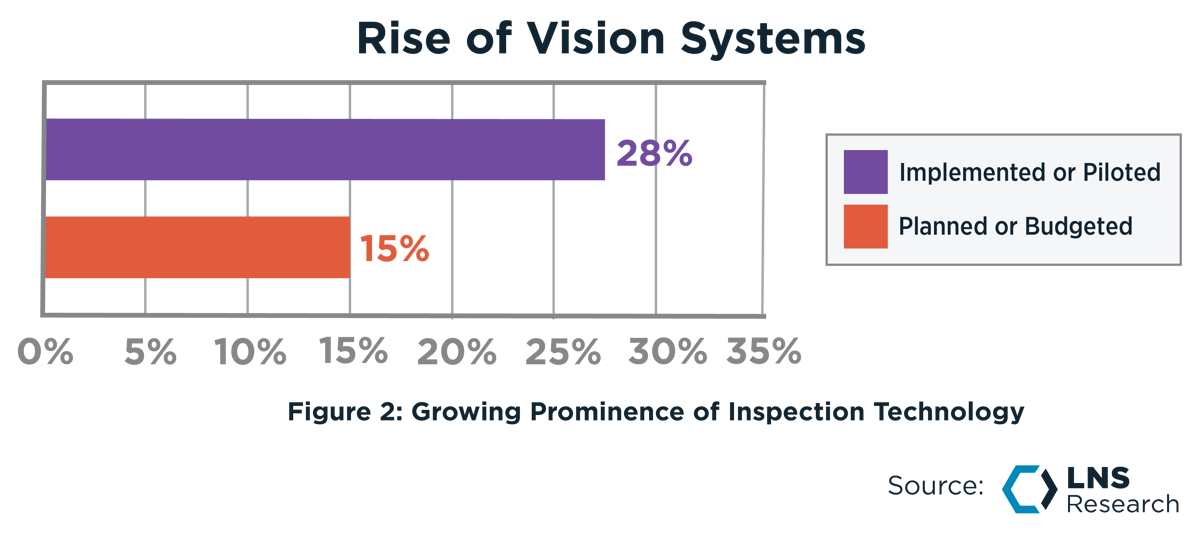
-
Machine Learning is applied to process optimization and problem-solving tasks.
We see the beginnings of the application of Machine Learning in the Quality space. The primary use cases for it currently are around gathering events into groupings, suggesting likely causes, and possible solutions for things like customer complaints, non-conforming material reports, Corrective & Preventive Actions, and similar events.
-
Robotic Process Automation (RPA) is reducing the necessary manual touch-points.
Robotic Process Automation is the application of logic to events managed within a software system. RPA reduces the number of keystrokes and human touchpoints needed to make a process function.
-
Quality 4.0 is led from outside the Quality function.
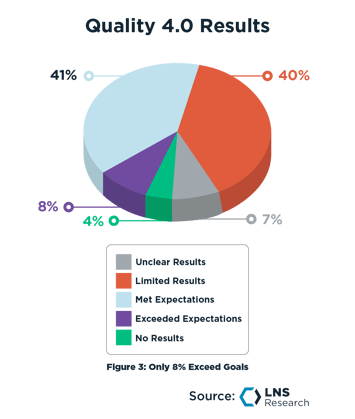 Our Quality 4.0 research shows that the vast majority of Quality 4.0 programs today are led by someone outside the quality function (80%)! The majority are led by IT or Operations leadership. As a result, these programs are done TO Quality instead of WITH Quality. Perhaps not surprisingly, they focus on reducing the cost of the Quality function within the organization rather than adding value across the value chain. Perhaps it is unsurprising that most Quality 4.0 programs struggle to achieve their intended goals, with only 8% exceeding planned goals. (Figure 3)
Our Quality 4.0 research shows that the vast majority of Quality 4.0 programs today are led by someone outside the quality function (80%)! The majority are led by IT or Operations leadership. As a result, these programs are done TO Quality instead of WITH Quality. Perhaps not surprisingly, they focus on reducing the cost of the Quality function within the organization rather than adding value across the value chain. Perhaps it is unsurprising that most Quality 4.0 programs struggle to achieve their intended goals, with only 8% exceeding planned goals. (Figure 3)
Looking ahead to the next seven years
The next seven years will see a dramatic shift in technology acceptance in the Quality functions. AI is nascent but holds the key to the dramatic improvement in manufacturing quality. Digital Twins are in the experimentation phase now and, by 2030, will be widely accepted for modeling processes, products, design, improvement of existing products and processes, and training of new associates.
What will drive this dramatic shift in mindset around technology acceptance by Quality Leaders? A few simple things;
-
-
-
Pressure from the labor market
-
Demands of Gen-Z workers for technology
-
Maturation of advanced applications like Analytics, ML & AI
This combination of factors will force acceptance because there will be no other option.
As the labor crisis grows with the retirement of Gen-X and the last of the Baby Boom generation, expertise will walk out the door with them. One challenge for the next seven years will be how to standardize experiential knowledge into a system, making it available to future generations of workers. IX Leaders are experimenting with unique and novel ways to apply Machine Learning and Artificial Intelligence, including capturing human knowledge.
Our latest State of IX Tech research shows that significant investments in leading-edge digital technology are planned for the next 1-3 years. This says two things that inform my previous statements about pressure on Quality Leaders;
-
-
-
Many organizations engaged in transformation view these technologies as viable and worthy of investment. (Figure 4)
-
These additional investments will drive innovation in the application of these leading-edge technologies and expand what is possible.
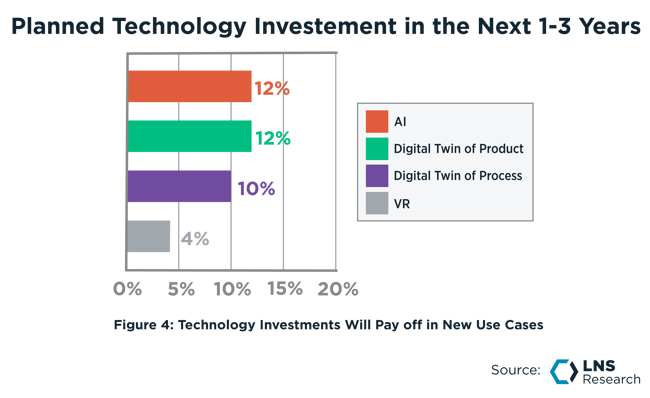
What will 2030 bring?
AI Applied to manufacturing quality will achieve Prognostic Quality
Artificial Intelligence will grow beyond ChatGPT today to something closer to the Columbia University definition of mimicking human thought. AI applied to manufacturing’s quality problems will open a new era of Prognostic Quality as understanding the embedded process and product relationships develops and matures. Our latest State of IX Technology research shows that 12% are planning investments in AI in the next 1-3 years. This window for investment in critical technologies will pay off as more and more Quality 4.0 programs can leverage these technologies into applications to add value across the value chain.
Digital Twin and Virtual Reality will apply to Problem Solving and Training
Quality has some responsibility for competence and training of associated performing work affecting Quality. Digital Twins, coupled with AI and VR, will grow in prominence in determining new associates' competence to perform work.
Digital Twins of plant, process, and product can serve as the basis for VR representations of complex processes for training purposes. This transfer of ownership is necessary as the Gen-X workforce will be largely retired by 2030, taking their expertise with them. Digital Twins will also be a key component of Digital Performance Excellence (DPX) by 2030. Here again, our State of IX technology research shows that between 10% and 12% are planning for investments in Digital Twins of product and process within the next 1-3 years. We expect this will accelerate as more real-world use cases show the way for followers to envision how to apply these leading-edge technologies to their own manufacturing situations.
Other touchless measuring technology will make the transition to digital enablement
Today there is much talk about Vision Cameras for robots enabling roving visual inspections. There is a host of other non-contact measurement tech that can benefit from this approach as well. Laser micrometry, Ultrasonic micrometry, and X-ray all have roving use case potential, minimizing expenditure for installations dedicated to lines and products, a cost-prohibitive approach currently the norm. In our latest State of IX Tech research, nearly 50% of manufacturers are planning for automated inspections or already doing them. We expect this trend to continue to grow. (Figure 5)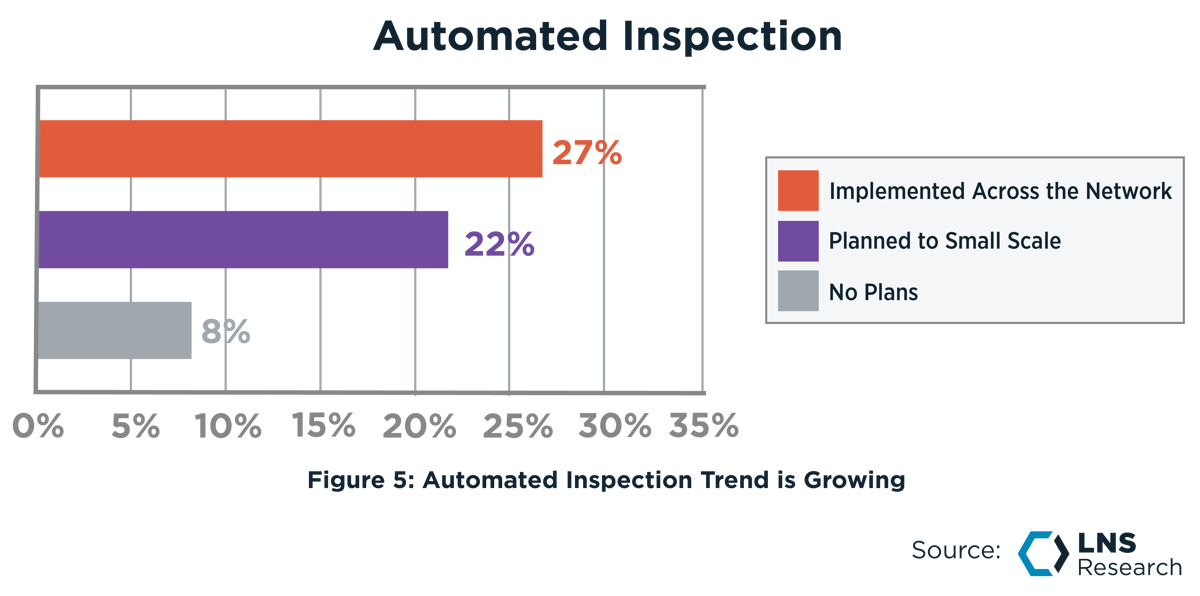 2030 seems like the realm of science fiction. Still, it is only seven years away, and these applications and combinations are already being tested and fine-tuned in the Industrial Transformation eco-space. The next seven years will see a hockey stick of acceptance of technology applied to Quality responsibilities because there won’t be people to perform them.
2030 seems like the realm of science fiction. Still, it is only seven years away, and these applications and combinations are already being tested and fine-tuned in the Industrial Transformation eco-space. The next seven years will see a hockey stick of acceptance of technology applied to Quality responsibilities because there won’t be people to perform them.
Recommendations for Quality Leaders
There are a couple of things that today’s Quality Leaders can do to prepare for 2030.
-
-
-
Embrace Technology Experimentation. Experimentation is messy. Sometimes experiments show you what not to do and allow you to develop your approach to using technology to solve your unique Quality challenges. Start now to build your suite of technology tools to bridge the future gaps in Quality operations.
-
Get engaged in your Quality 4.0 Transformation. Seven years will pass in the blink of an eye. Quality Leaders need to be planning now for what they would like to have implemented as part of their Quality 4.0 long-term strategy for 2030. Transformation takes a long time. Our previous Quality 4.0 research showed an average of almost five years for the journey to Quality 4.0. Quality leaders must start now for their efforts to pay off by 2030.
-
Put experienced people in charge of codifying knowledge. There are only a few years left to capture as much experiential knowledge from the heads of Gen-X and Baby Boomers before they exit. Enlist their assistance in creating and standardizing that knowledge for AI, VR, and Digital Twins to leverage in the future.
This year, The IX Event in Chicago is the place to learn cutting-edge insights that will help accelerate your efforts to succeed and pitfalls to avoid as you progress on your journey to Operation 2030. We have a large number of roundtable-sharing opportunities for Quality Leaders, IX Leaders, COOs, and CIOs, among others. Early registration is open now. Check it out here.
